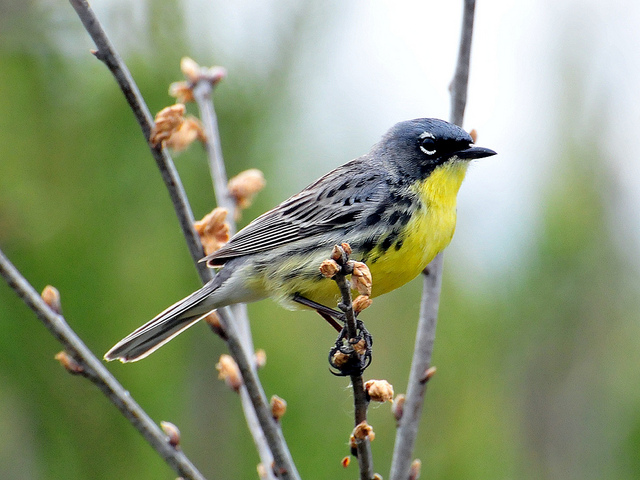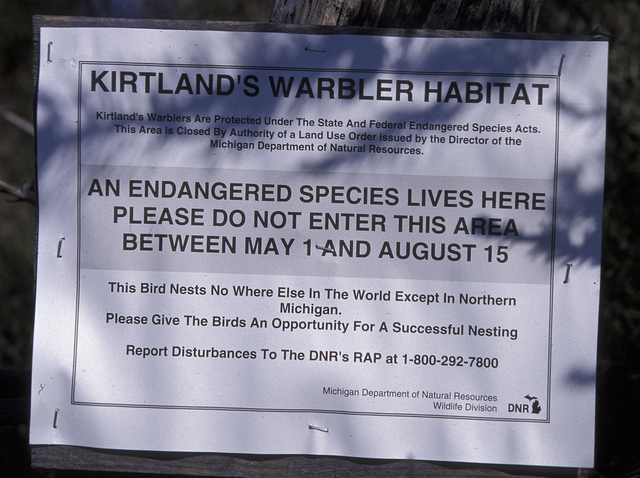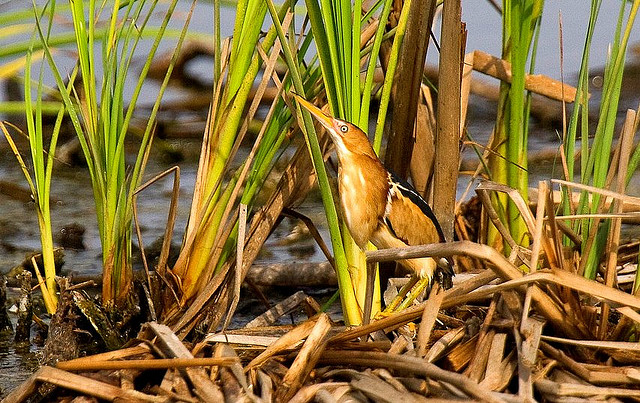
Kirtland’s warbler populations are in danger since the birds only nest in Grayling, MIch. Photo: United States Fish and Wildlife Service
Editor’s note: Echo’s Winged Wednesday series reports on expert birders’ favorite Great Lakes birds to watch. Tell us your favorites in the comments.
Sean Williams, a second-year doctoral student studying zoology at Michigan State University, is no stranger to hunting down rare birds.
Williams spotted a remarkable 249 different species of birds in Peru in one day. But, while not traveling for research, he enjoys birding around Michigan.
“One of the rarest ones in our region is the bird called the Kirtland’s warbler,” Williams said. “They’re a really nice looking bird.”

A sign in Grayling, Mich. warns visitors to not enter the nesting area of Kirtland’s warblers. Photo: Marcel Holyoak
Kirtland’s warbler, also known as jack pine warblers, only breed in the jack pines of Michigan, he said. In the winter, they fly to the Bahamas. Kirtland’s warblers used to be present in Minnesota and parts of Canada where jack pine trees could be found, however those populations were wiped out.
In the same bird family is another one of Williams’ picks: the cerulean warbler. These bright blue birds are also rare due to declining habitat.
“Cerulean warblers are kind of a sky blue bird that’s only here in the summer,” Williams said. “We get them in some large intact forests where they show up to breed. There aren’t many of those now because a lot of forests are being turned into farm fields.”
If you’re a birder near grasslands, one bird to keep an eye out for is Henslow’s sparrow, a bird that oddly prefers to run from predators rather than fly. Henslow’s sparrow breed during the summer in Wisconsin, Illinois, Indiana, Ohio, Pennsylvania, Michigan and the Toronto area.
“Grassland is a very uncommon habitat, and this sparrow is specialized to live only in this habitat,” Williams said. “They’re really nice to see, though there are not many around.”

Is it a plant, or is it a least bittern? It’s hard to tell at first glance! Photo: Francesco Veronesi
For birders looking for a bit of a challenge, least bittern are small herons that have a special way of camouflaging themselves, making them a tricky catch.
“Least bittern are rare birds of marsh habitat,” Williams said. “It’s a really small heron that breeds in the cattail marshes.”
Least bittern have a very funny way of handling predators. Since these small herons reside in marshland, they will cling to reeds, turn their beaks skyward, and sway slightly to resemble reeds.